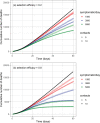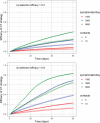Modelling the impact of contact tracing of symptomatic individuals on the COVID-19 epidemic
- PMID: 33787657
- PMCID: PMC7978843
- DOI: 10.6061/clinics/2021/e2639
Modelling the impact of contact tracing of symptomatic individuals on the COVID-19 epidemic
Abstract
Objectives: With the declining numbers of coronavirus disease 2019 (COVID-19) cases in the state of São Paulo, Brazil, social distancing measures have gradually been lifted. However, the risk of a surge in the number of cases cannot be overlooked. Even with the adoption of nonpharmaceutical interventions, such as restrictions on mass gatherings, wearing of masks, and complete or partial closure of schools, other public health measures may help control the epidemic. We aimed to evaluate the impact of the contact tracing of symptomatic individuals on the COVID-19 epidemic regardless of the use of diagnostic testing.
Methods: We developed a mathematical model that includes isolation of symptomatic individuals and tracing of contacts to assess the effects of the contact tracing of symptomatic individuals on the COVID-19 epidemic in the state of São Paulo.
Results: For a selection efficacy (proportion of isolated contacts who are infected) of 80%, cases and deaths may be reduced by 80% after 60 days when 5000 symptomatic individuals are isolated per day, each of them together with 10 contacts. On the other hand, for a selection efficacy of 20%, the number of cases and deaths may be reduced by approximately 40% and 50%, respectively, compared with the scenario in which no contact-tracing strategy is implemented.
Conclusion: Contact tracing of symptomatic individuals may potentially be an alternative strategy when the number of diagnostic tests available is not sufficient for massive testing.
Conflict of interest statement
No potential conflict of interest was reported.
Figures







Similar articles
-
Impact of delays on effectiveness of contact tracing strategies for COVID-19: a modelling study.Lancet Public Health. 2020 Aug;5(8):e452-e459. doi: 10.1016/S2468-2667(20)30157-2. Epub 2020 Jul 16. Lancet Public Health. 2020. PMID: 32682487 Free PMC article.
-
The impact of social distancing, contact tracing, and case isolation interventions to suppress the COVID-19 epidemic: A modeling study.Epidemics. 2021 Sep;36:100483. doi: 10.1016/j.epidem.2021.100483. Epub 2021 Jul 13. Epidemics. 2021. PMID: 34284227 Free PMC article.
-
Mathematical modeling of the transmission of SARS-CoV-2-Evaluating the impact of isolation in São Paulo State (Brazil) and lockdown in Spain associated with protective measures on the epidemic of CoViD-19.PLoS One. 2021 Jun 15;16(6):e0252271. doi: 10.1371/journal.pone.0252271. eCollection 2021. PLoS One. 2021. PMID: 34129608 Free PMC article.
-
[What is the effect of social distancing on the course of COVID-19 epidemic?].Pol Merkur Lekarski. 2021 Feb 24;49(289):71-79. Pol Merkur Lekarski. 2021. PMID: 33713099 Review. Polish.
-
Nonpharmaceutical public health interventions to curb the COVID-19 pandemic: a narrative review.J Infect Dev Ctries. 2022 Apr 30;16(4):583-591. doi: 10.3855/jidc.14580. J Infect Dev Ctries. 2022. PMID: 35544617 Review.
Cited by
-
Modelling the impact of delaying vaccination against SARS-CoV-2 assuming unlimited vaccine supply.Theor Biol Med Model. 2021 Jul 29;18(1):14. doi: 10.1186/s12976-021-00143-0. Theor Biol Med Model. 2021. PMID: 34325717 Free PMC article.
-
Mathematical Contact Tracing Models for the COVID-19 Pandemic: A Systematic Review of the Literature.Healthcare (Basel). 2025 Apr 18;13(8):935. doi: 10.3390/healthcare13080935. Healthcare (Basel). 2025. PMID: 40281884 Free PMC article. Review.
-
Compartmental structures used in modeling COVID-19: a scoping review.Infect Dis Poverty. 2022 Jun 21;11(1):72. doi: 10.1186/s40249-022-01001-y. Infect Dis Poverty. 2022. PMID: 35729655 Free PMC article.
-
Evaluating the impact on health outcomes of an event that resulted in a delay in contact tracing of COVID-19 cases in England, September 2020: an observational study.BMJ Open. 2023 Oct 12;13(10):e064982. doi: 10.1136/bmjopen-2022-064982. BMJ Open. 2023. PMID: 37827740 Free PMC article.
References
-
- Seade (Fundação Sistema Estadual de Análise de Dados) População do Estado de São Paulo. 2020. Available from: https://www.seade.gov.br [Cited May 25th, 2020]
-
- Seade (Fundação Sistema Estadual de Análise de Dados) SP contra o novo coronavírus: boletim completo. 2020. Available from: https://www.seade.gov.br [Cited October 30th, 2020]
-
- Horton J. BBC News. 2020. Coronavirus: What are the numbers out of Latin America? Available from: https://www.bbc.com/news/world-latin-america-52711458 [updated September 23rd, 2020; Cited November 2nd, 2020]
MeSH terms
LinkOut - more resources
Full Text Sources
Other Literature Sources
Medical

